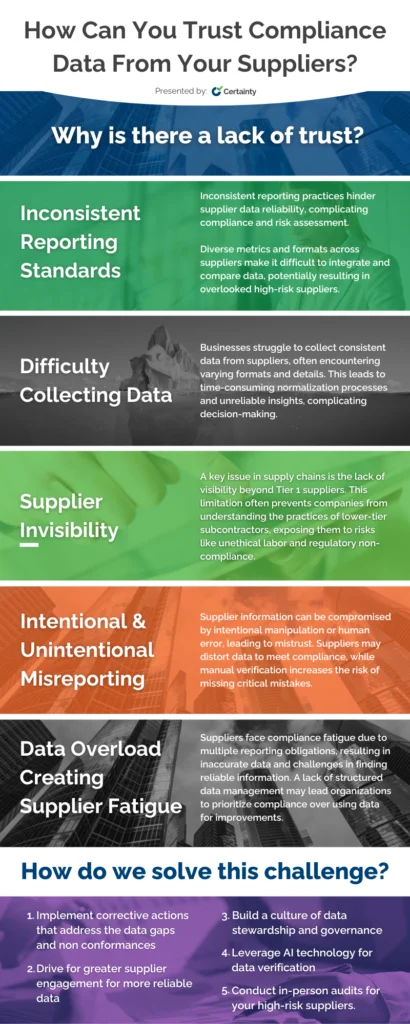
The Growing Risk of Unverified Supplier Data
Businesses in today’s economy operate in a landscape where supply chains stretch across multiple continents, involving countless third parties. With so many moving parts, a fundamental question arises: Can you trust the data your suppliers provide? Every compliance report, quality certification, and ethical sourcing claim is only as reliable as the systems in place to verify them. Yet, time and time again, companies discover—often too late—that the data they relied on was inaccurate, manipulated, or outright false.
The consequences of unverified supplier data can be severe. Regulatory non-compliance can result in hefty fines and legal action. Quality failures can trigger mass product recalls, losing millions in revenue. Ethical breaches—such as labor exploitation or environmental destruction—can permanently damage brand reputation and erode consumer trust. One weak link in your supplier data integrity can shock the entire organization, turning blind trust into costly missteps.
As supply chains expand and digital transformation accelerates, organizations collect more supplier data than ever. However, verification processes often lag, creating a dangerous gap between reported and actual supplier performance. Many businesses still depend on self-reported data, manual documentation, and outdated validation methods—leaving them vulnerable to human error, data manipulation, and supply chain opacity.
So, how can companies move beyond blind trust and take control of supplier data integrity? This article explores the most pressing challenges undermining supplier data accuracy. We’ll present actionable solutions to ensure your organization builds a competitive advantage—one that you can trust the information you receive, mitigate risk, and own a resilient, transparent supply chain.
Problems Reducing the Trustworthiness of Supplier Data
Inconsistent Reporting Standards
A lack of standardized reporting practices is a fundamental obstacle to supplier data reliability. Suppliers across industries, regions, and business sizes report data using different metrics, methodologies, and formats. Without a universally recognized framework for gathering and validating supplier data, companies are left to aggregate information ad-hoc. This has led to gaps in compliance tracking, risk assessment, and quality assurance.
This inconsistency becomes even more problematic when organizations engage with a diverse array of suppliers across multiple product categories and service areas. The inability to integrate and compare accurate supplier data effectively makes it nearly impossible to identify discrepancies, enforce standards, or assess compliance levels at scale. A misalignment in reporting structures can cause businesses to overlook high-risk suppliers simply because the information they receive lacks clarity or is presented in an incompatible format.
Difficulty Collecting Consistent, Comparable Data
Even when suppliers provide data, businesses face an additional challenge: collecting data in a way that is consistent and comparable across suppliers, regions, and product categories. Many organizations struggle with data arriving in different formats, languages, or levels of granularity, making it difficult to analyze and compare supplier performance effectively.
This lack of consistency often forces companies to spend excessive time normalizing data—manually converting reports into compatible formats, reconciling discrepancies, and attempting to extract meaningful insights from fragmented information. Without a structured approach, businesses may find that supplier data lacks the reliability needed for accurate decision-making.
Tip:
Standardized data collection ensures more reliable supplier assessments. Certainty Software provides configurable self-assessment forms, allowing suppliers to report against the same compliance requirements. This reduces manual reconciliation efforts and improves data consistency for better decision-making.
Many Companies Don’t Know Who Their Suppliers Are
A significant issue in today’s supply chain is that there’s little visibility beyond Tier 1 suppliers. Though ideally, companies maintain a direct relationship with their suppliers (Tier 1), they often lack visibility concerning Tier 2, Tier 3, and lower-tier subcontractors. As a result, these businesses are exposed to threats from non-disclosure of outsourcing, supply chain management snags, and regulatory non-compliance.
Companies may allow their first-tier suppliers to pursue unsubstantiated subcontracting, thereby increasing the risk that these operations engage in unethical labor practices, procure raw materials from environmentally damaging operations, or fail to comply with safety and quality regulations. When companies fail to have full visibility into every level of the supply chain, they cannot properly assess supplier risk or enforce compliance. If there are shortcomings in your understanding of your supply chain, your organization is blind to risk. The consequences of this blind spot can be severe, particularly in industries with stringent regulatory requirements or high public scrutiny regarding corporate responsibility.
Intentional and Unintentional Misreporting
Supplier information can be compromised either through intentional manipulation or unintentional inaccuracies. Some suppliers, facing pressure to meet compliance requirements, may distort data to maintain business relationships or avoid penalties. Many industries see the supplier data compromised as suppliers are rated on key performance indicators (KPIs) related to safety, sustainability, ESG, and financial performance.
Even with no intention of manipulation, human error remains a significant factor in supplier mistrust. Calculations mistakes, data entry errors, or documentation lapses can create discrepancies that damage trust in supplier data. Given the sheer volume of processed information, organizations that rely on manual verification methods are at an increased risk of overlooking critical errors or inconsistencies.
Data Overload Causing Supplier Fatigue
Many suppliers experience compliance fatigue due to the sheer number of reporting obligations imposed by various clients, regulatory bodies, and industry standards. This can lead to hastily submitted, incomplete, or inaccurate data. Businesses often suffer from information overload, which prevents them from sufficiently differentiating between trustworthy and untrustworthy supplier data.
Without a structured process for managing and collecting data, organizations risk falling into a cycle of reactive compliance. This is where information is being collected to meet reporting requirements rather than being used actively to drive supplier improvements.
Access Free Supplier Sustainability Management Checklists
Download turn-key Excel checklists built by our experts.
Supplier Corrective Action Report Form
Supplier Social and Environmental Compliance Checklist
Solutions to Ensuring Reliable Supplier Data and Build Trust
Implement Corrective Actions to Address Data Gaps & Non-Conformance
Identifying inconsistencies in supplier data is just the start of the process, steps must be taken to rectify inaccuracy and ensure adherence. Consistent and traceable corrective actions ensure accountability and support continuous improvement throughout the supplier ecosystem.
Best practices for corrective actions include:
- Establishing clear resolution timelines to ensure timely corrective measures.
- Escalating repeat violations with stricter enforcement mechanisms.
- Maintaining an audit trail to identify patterns and prevent recurring non-compliance.
Drive Supplier Collaboration & Engagement for More Reliable Data
To make supplier data management effective, there should be a shift from a one-way compliance model to a more collaborative act where suppliers are treated as partners rather than just entities to provide data. A punitive or purely compliance-driven approach often leads to resistance, while engagement fosters transparency and data integrity.
Strategies for improving supplier collaboration include:
- Setting Up Of Communication Channels For Any Reporting Query
- Onboard the supplier to your practices and support continuously
- Encouraging data contributors to provide high-quality submissions.
Engaged suppliers find it more worthwhile to report accurately so the integrity of data increases along with the trust of the company and its supply chain. One of the most effective ways to deepen supplier engagement is to ensure they understand why their data matters. Providing feedback on how their submissions impact operations, compliance, or even sustainability goals makes the process more meaningful.
For example, sharing performance dashboards or benchmarking reports allows suppliers to see how they compare to industry standards and identify areas for improvement.
Establish a Culture of Data Stewardship and Governance
Data stewardship is a fundamental pillar of supplier data integrity. Organizations must ensure that internal teams and suppliers are equally committed to maintaining data accuracy. A structured governance framework ensures that data validation is not a one-time effort but an ongoing process.
Key elements of a strong data stewardship program include:
- Defining clear roles and responsibilities for supplier data management.
- Adopting industry-recognized data quality standards (such as ISO, GFSI, or other regulatory frameworks).
- Conducting regular audits of internal and external data processes to identify gaps and enforce consistency.
A well-implemented data governance framework strengthens supplier accountability and builds trust across your supply chain. When suppliers and internal teams align on data integrity, organizations gain a reliable foundation for decision-making. Clear governance ensures accurate, verifiable data drives compliance, enhances operational efficiency, and mitigates risk—transforming data stewardship from a regulatory requirement into a strategic advantage.
Leverage Automation to Verify Data (Prevent Supplier Fatigue)
Artificial intelligence (AI) and automation offer revolutionary capabilities for supplier data verification. Machine learning algorithms can rapidly analyze large volumes of supplier reports, identifying anomalies and inconsistencies that human reviewers may overlook.
AI-driven tools can enhance data accuracy by:
- Detecting suspicious or outlier data in real-time.
- Reducing the burden of manual data review by automating verification processes.
- Utilizing dynamic forms that adapt based on previous supplier responses, minimizing redundant questions and preventing compliance fatigue.
Certainty Software has recently launched AI-driven audit and inspection tools that streamline and automate the supplier data collection, insight management, and reporting processes. Discover more about Certainty AI.
Conduct Targeted In-Person Audits for High-Risk Suppliers
While digital verification methods have advanced, physical audits remain essential for supplier compliance. Certain risks—such as workplace safety violations or ethical sourcing concerns—can only be fully assessed through direct inspection.
To optimize audit efficiency, organizations should:
- Use risk-based audit scheduling to focus on high-risk suppliers.
- Implement standardized audit protocols to ensure consistency across regions.
- Leverage digital audit checklists to reduce manual errors and streamline reporting.
A hybrid approach that combines AI-driven data validation with targeted in-person audits provides the most comprehensive framework for ensuring supplier data integrity. AI rapidly processes large volumes of supplier data, identifying inconsistencies, gaps, or potential real-time risks. However, digital verification alone cannot capture the full picture—certain compliance risks, such as ethical sourcing concerns, unsafe labor conditions, or product quality defects, require direct human inspection to verify adherence to standards.

Building Supplier Data Trust in a Digital-First World
Ensuring supplier data integrity is critical for compliance risk mitigation, preventing disruptions, and safeguarding brand reputation. Adopting proactive, technology-driven verification methods strengthens trust in your supply chain data and helps you make more informed decisions. Corrective actions, supplier relationships, AI-driven validation, and targeted audits create a robust framework for sustainable supplier data reliability.
Trust Certainty Software to help you manage supplier self assessment data collection, corrective action management, and enterprise-wide reporting with our collection of supplier management tools. Schedule your demo today to learn more about Certainty Software.
Other articles you may be interested in:



